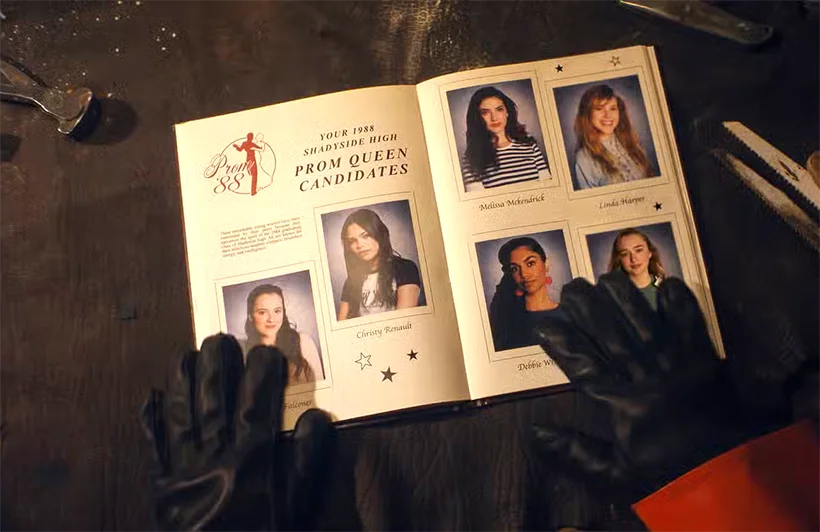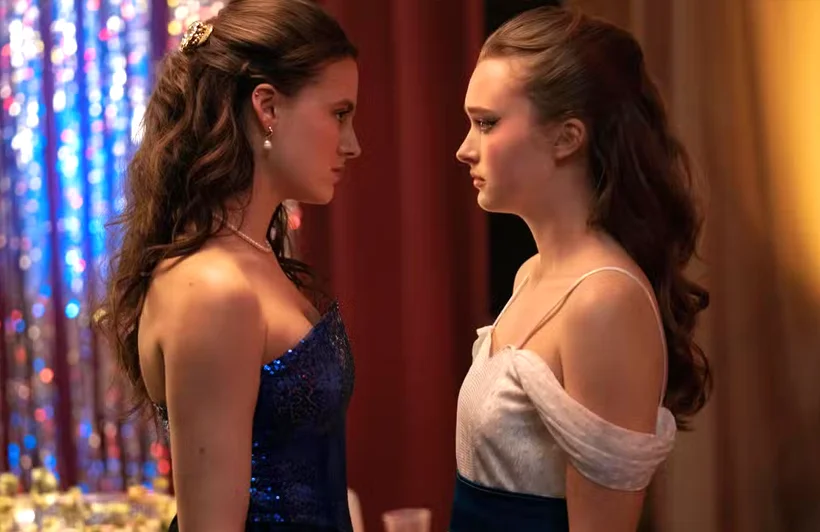Type and hit Enter to search
Experts in aesthetic surgery, dermatology, and beauty bring you the latest trends, research, and advice to help you make informed decisions about your appearance and health.
A web platform dedicated to aesthetic surgery, dermatology, and beauty, where expertise meets innovation, and your desires and needs become our mission. In a world where appearance and health go hand in hand, our platform leads the revolution, delivering the latest trends, research, and expert advice directly to you.
Our team consists of highly skilled professionals in the fields of aesthetic surgery and dermatology, committed to providing reliable information and guidance that will help you make informed choices about your appearance and well-being. We understand that every individual has unique needs and desires, which is why we approach each person with the utmost care and professionalism.
Powered by Aestetica Web Design © 2024
I decoded Fear Street: Prom Queen Post-Credits Scene—Turns out, it was just the beginning
I didn’t expect Fear Street: Prom Queen to hit me with a blood-symbol cameo after 90 minutes of limp dialogue and prom hair politics—but here we are. The Fear Street: Prom Queen Post-Credits Scene drops a subtle but sinister breadcrumb that yanks us back into Shadyside’s cursed legacy. I rolled my eyes more than once during the movie, but that final crimson flourish? It slapped harder than half the kills. Let’s break down what Netflix buried in those last 30 seconds and why I’m side-eyeing the Goode family all over again.
I Stayed Through Fear Street: Prom Queen Post-Credits Scene and Found Evidence of Horror’s Perfect Crime
The Devil’s Mark Returns: A Bloody Callback to the Original Trilogy
If you were still recovering from the prom bloodbath, you might’ve missed it—the one moment Fear Street: Prom Queen decides to quietly flirt with actual menace. Nancy Falconer’s body, sprawled and cooling, leaks a crimson puddle that twists into the shape of the Witch’s Mark. Not just a fun little splatter gag—this is the symbol that tied Shadyside’s darkest curses together in the original trilogy.
No fanfare. No ominous violin sting. Just that steady trickle of blood curling into the emblem that ruined entire generations. It’s subtle, almost tasteful—which is more than can be said for most of the film’s carnage. For a franchise that once danced across centuries with style, this callback lands like a whisper in a room full of shouting. And somehow, that’s what makes it stick.
What if Nancy was never just another psychopath?
Now the question lingers like the scent of stale hairspray and burnt corsage: what if Nancy Falconer wasn’t just your run-of-the-mill murder mom with a prom fixation? The Witch’s Mark changes the frame. It suggests she may have been part of something older, darker, and entirely out of her control. The Goode family’s signature evil isn’t exactly subtle—and Nancy might be more than just a villain with a vendetta.
Could she be another one of the sacrifices? A long-game pawn in the Shadyside cycle of doom? The math almost adds up: she murdered Lori’s dad 18 years ago. If she’d been marked back then, her descent into vengeance could have been less madness, more design. Suddenly, her obsession with Tiffany winning prom queen reads less like a twisted pageant mom fantasy and more like the cursed logic of someone who’s been dancing on the edge of a supernatural pit for decades.

A Missed Opportunity: The Cut Cameo That Could’ve Been
The crossover we nearly got but totally didn’t deserve
In a classic case of Netflixing-it-up, the film nearly included a crossover moment that might have salvaged some franchise cohesion—but ultimately didn’t bother. According to Matt Palmer, there was a version of the ending that would’ve featured a character from the original trilogy. A face from Camp Nightwing, or a survivor of the mall massacre, sliding in during the credits like Nick Fury recruiting a new Slayer. It would’ve been smart, efficient, and just fan-servicey enough to work.
But no. Instead of tethering Prom Queen to the wider Fear Street mythos in a meaningful way, the filmmakers opted for a blood puddle and vibes. We’re left imagining the alt-ending where Deena Johnson walks into frame with that look—you know the one that says, “I’ve killed before, and I’ll do it again.” Alas.
Why that missing scene actually matters
The absence of the cameo isn’t just a fanboy gripe. It signals a larger issue: Prom Queen doesn’t know whether it wants to be a standalone or a sequel. It flirts with lore, drops a couple of references, then backs away slowly like someone who just remembered they left the stove on. A brief appearance by an original cast member could’ve grounded the film in something—anything—other than high school caricatures and murder-by-number plotting.
Instead, the film hangs in tonal limbo. Not quite homage, not quite reboot, not quite expansion. Just… there. Floating in the Netflix void. And when your post-credits scene is the most interesting thing you’ve got going? That missing 45 seconds might’ve made all the difference.
Prom Night Carnage: Who Survived and Who Didn’t
Lori Granger: From Outcast to Final Girl
If there’s one thing horror loves more than a bloodbath, it’s a good old-fashioned final girl transformation—and Fear Street Prom Queen gives us one with Lori Granger. When we first meet her, Lori’s the quietly ambitious girl from the wrong side of the tracks, exuding that familiar wallflower energy that usually earns a one-way ticket to “dead by second act.” But somewhere between ducking stab wounds and watching her peers drop like confetti, she evolves. Not just into a survivor, but into the kind of horror heroine who finally shouts her name in a way that dares the curse to come back for round two.
The film doesn’t give her much subtlety, but India Fowler does what she can with it—adding a trace of steel to Lori’s soft-spoken doubt. You can feel the gears turn in her head when things go sideways, which is more than can be said for most of the script. By the time she snarls, “I’m Lori f—ing Granger,” it’s not just cathartic—it’s overdue.
Prom queen bloodbath doesn’t crown her by accident
What makes Lori’s arc click, even in this sometimes-limp slasher, is that she earns her survival. Unlike horror flicks that protect their final girl through sheer plot armor (looking at you, Halloween Kills), Lori’s endurance feels reactive and deliberate. She makes hard calls. She protects her best friend. She’s not just dragged to the finish line screaming—she claws her way there, soaked in blood and, somehow, clarity.
There’s also a smart subversion tucked beneath the fake eyelashes and tiaras. This isn’t just the tale of a high school underdog proving herself. It’s the unraveling of generational shame—Lori spends the movie trying to outrun a mother falsely branded a killer, only to discover she’s got her own bloody legacy to wrestle with. That makes her not just a survivor, but a story reset button. The last girl standing isn’t trying to carry the Fear Street curse forward. She’s trying to end it.

The Falconer Family Affair: Killers Revealed
Dan and Nancy Falconer: PTA nightmares with knives
Let’s be honest—when it comes to Fear Street Prom Queen killers, subtlety has left the chat. Dan and Nancy Falconer are the kind of over-the-top, Stepford-villain couple who’d bake poisoned cookies just to ensure Tiffany wins class president. Their entire murderous scheme feels like a cross between Carrie‘s mom and The Purge’s HOA board. What’s their motive? Tiffany must win prom queen at all costs—because apparently, therapy is too mainstream.
The reveal isn’t handled with suspense so much as brute force. The Falconers are never really given enough screen time to breathe as characters, which makes their bloodthirsty motivations land somewhere between absurd and half-baked. And yet, it fits the film’s overall tone—style over nuance, spectacle over logic. This is a prom where the stakes are slathered in melodrama, and the Falconers understood the assignment.
Tiffany Falconer: Complicit, conditioned, or just deranged?
Tiffany is the film’s wild card—initially framed as the mean girl foil, she winds up in murkier moral waters. The twist? She’s technically not wielding the knife during the prom massacre (too busy perfecting her crown pose), but she does try to kill Lori later, which gives her a solid foot in the psychopathic door. And given the body count racked up by her parents, “complicity by osmosis” feels like the most generous read.
What’s almost interesting—emphasis on almost—is how the movie teases nature versus nurture. Tiffany’s entitled rage, her meltdown when she loses the crown, her warped sense of justice… all of it seems inherited. Not genetically, but culturally. She was raised by murderers, and it shows. Her character is less a villain than a cautionary tale: what happens when you grow up in a house where stabbing someone is considered conflict resolution.
For a film so gleefully messy, the Falconer family unit is its most consistent source of horror and satire. And while their backstory could’ve used more meat, the dysfunction they represent is just credible enough to sell the idea that in Shadyside, even a high school pageant can end in ritual slaughter. That’s commitment. Or maybe just a particularly aggressive case of parental overreach.
Critical Reception: A Dance with Disappointment
Critics’ Verdict: A Lackluster Addition to the Franchise
It’s never a good look when the highlight of your movie is a blood puddle in the credits. But that’s where we land with Fear Street: Prom Queen, which critics mostly filed under “we’ve seen this prom before—and better.” The film currently floats at a less-than-stellar 32% on Rotten Tomatoes, which is barely above “Netflix background noise” territory. And considering its predecessors were lauded for revitalizing teen horror with heart and wit, this drop feels less like a stumble and more like a faceplant into spiked punch.
The main gripe? It’s all surface-level nostalgia with no pulse underneath. Reviewers from outlets like The Daily Beast and Bloody Disgusting called out the film’s paint-by-numbers structure, lazy plotting, and lack of original tension. Yes, it tries to lean into ‘80s slasher homage, but instead of embracing the genre’s chaotic charm, it ends up copy-pasting tropes without the tension or character work that made its influences tick. Imagine trying to remix Carrie and I Know What You Did Last Summer—and forgetting to bring the suspense.
A franchise with flair, reduced to a streamer algorithm ghost
Part of what made the original trilogy sing was its ambition. Three interwoven timelines, a tonally daring blend of horror and queer romance, and a refreshing sense of confidence. Prom Queen, by comparison, feels like the ghost of Fear Street past—drifting without direction, hollowed out by corporate caution.
There’s an unavoidable “Netflix-ification” at play here. You can feel the algorithm humming beneath every frame, smoothing edges, flattening characters, sanding off risk. It’s horror with all the spice boiled out. Critics noted how even the kills lacked bite—poorly choreographed, tension-free, and more obligatory than impactful. One standout moment involving severed hands and a doorknob aside, the violence is oddly sterile for a franchise that once reveled in bold, genre-pushing gore.
In short, the Fear Street Prom Queen critical reception overview isn’t just disappointed—it’s baffled. Critics aren’t mad; they’re just confused how something with this much built-in momentum ended up so utterly… beige.
Audience Reaction: Nostalgic or Nonsensical?
The Reddit war: Love letter or lazy rerun?
Over in the wild west that is Reddit, reactions to Prom Queen are, predictably, a knife fight in the comments section. Some users praised the film’s earnest nods to retro horror, giving it points for costume design and a few flashes of vintage synth-score charm. To them, it’s harmless genre fluff—an easy watch for a nostalgic Friday night.
Others? Not so forgiving. A popular thread in r/horror titled “Fear Street Prom Queen is the definition of wasted potential” pulls no punches. Users critiqued everything from the bland characters to the laughably rushed plot twists. The prom queen setup, while promising in concept, devolves into what one commenter called “a CW fever dream held together by bobby pins and plot holes.”
That’s the core divide: for some, it scratches a retro itch. For others, it’s a glitter-drenched mess that insults the intelligence of anyone who made it through the trilogy expecting the same caliber of storytelling.
Between scream and snooze: fan fatigue setting in?
The film’s release sparked a wave of discussion not just about Prom Queen itself, but about franchise fatigue. Even fans who defended the movie admitted it lacked the energy and purpose of the earlier films. The most generous takes framed it as a “light detour” or “spin-off that shouldn’t be taken too seriously.” But for many, especially those invested in the Fear Street lore, the letdown hit harder.
It’s a classic case of promise versus execution. The setup—a murder-riddled prom with legacy connections—was golden. But the delivery felt like a rough draft of a better film we didn’t get to see. The Fear Street Prom Queen fan opinions show a community both craving more Shadyside chaos and mourning the spark that made it great in the first place.
For now, the audience reaction feels like prom night itself: half the room dancing, the other half sneaking out early, heels in hand, mumbling, “Well… that happened.”
The Future of Fear Street: Where Do We Go from Here?
Potential Sequels: Will the Bloodbath Continue?
You don’t drop a Witch’s Mark in the middle of your Netflix Original™ without dangling a bloody breadcrumb trail toward a potential sequel—or three. Fear Street: Prom Queen might have limped across the finish line in terms of critical acclaim, but the mid-credits nod to the Goode family curse says one thing loud and clear: we haven’t seen the last of Shadyside’s signature murder tourism.
The blood forming the occult symbol doesn’t just tie Nancy Falconer to a past she probably didn’t even understand—it plants her squarely within the larger mythology. That’s franchise bait, plain and simple. Fans (or at least the ones who made it to the end without rage-quitting) have already started circulating Fear Street sequel rumors faster than a slasher villain in a corn maze. Is Nancy just another sacrifice? Will Tiffany return, fully unhinged? Is Lori destined to be the next Sarah Fier—or the last girl who breaks the loop?
Prom Queen might flop, but Shadyside’s still open for business
Even with its mixed reception, Prom Queen proves one thing: the Fear Street brand still has cultural traction. It survived the shift from theatrical ambition to Netflix content mill, which means it’s likely to survive one lukewarm outing too. And let’s be honest—Netflix doesn’t shy away from mining IP until it collapses into streaming dust. So while Fear Street Prom Queen sequel possibilities may feel a little shaky today, don’t be surprised if we’re back in Shadyside next year, watching a haunted graduation or cursed homecoming unfold.
That Witch’s Mark isn’t just a horror callback—it’s a business plan.
Lessons Learned: Balancing Nostalgia and Innovation
You can’t win hearts with hair spray and needle drops alone
There’s a fine line between homage and parody, and Prom Queen frequently stumbles straight into self-parody territory without even realizing it. It’s got all the trappings of a proper retro slasher—big hair, neon lighting, synth tracks—but none of the emotional spine or tension that made ‘80s horror stick around. It’s the cinematic equivalent of dressing like Freddy Krueger for Halloween and forgetting the glove.
The takeaway for anyone invested in the Fear Street franchise future is simple: you can’t coast on vibes. The trilogy thrived because it blended its winks to the past with fresh narrative ambition—a queer love story that actually mattered, a centuries-spanning curse with thematic meat. Prom Queen forgot to bring anything new to the table, which made all the references feel hollow.
Nostalgia’s a dessert, not a meal. And this one forgot the protein entirely.
Horror evolves—franchises have to evolve with it
Horror is one of the few genres that reinvents itself every few years. Found footage, elevated horror, horror-comedy, folk horror, trauma-core—we’ve seen entire movements rise and fall within a decade. And audiences, especially younger ones, expect more than recycled blood and bad wigs. They want subversion, purpose, characters that bleed metaphor as much as they bleed on screen.
That’s the real challenge for the Fear Street series evolution and challenges. Netflix has the sandbox, sure. But unless it lets creators play with sharp tools again—narratively speaking—it risks turning the franchise into a nostalgia graveyard. One that smells faintly of Aqua Net and missed opportunity.
It’s not about reinventing the wheel. It’s about remembering that horror, at its best, uses the wheel to run you over in a way you didn’t expect. The good news? Shadyside still has enough unresolved trauma to power ten more movies. But only if someone’s willing to dig deeper than “slasher, but make it prom.”
SOURCES:
4 Years Later, Netflix’s Most Promising Horror Movie Franchise Is Dangerously Close to Sending Fans Running, Fear Street: Prom Queen director on slashers & executing the perfect kill, Fear Street: Prom Queen Ending & Killer Identity Explained, Fear Street: Prom Queen Ending, Mid-Credits Scene & Sequel Explained, Fear Street: Prom Queen Director & Cast Preview Their Gory 1980s Party Movie, Who Lives, Who Dies, and Who Takes the Crown in Fear Street: Prom Queen?, Fear Street: Prom Queen Review – A Date to Forget.



